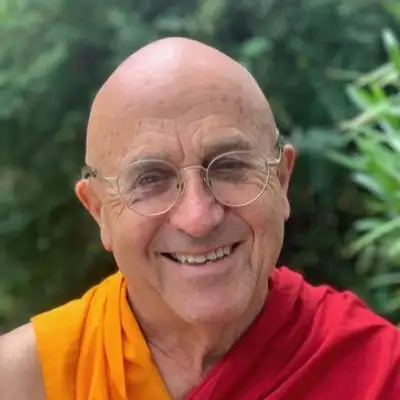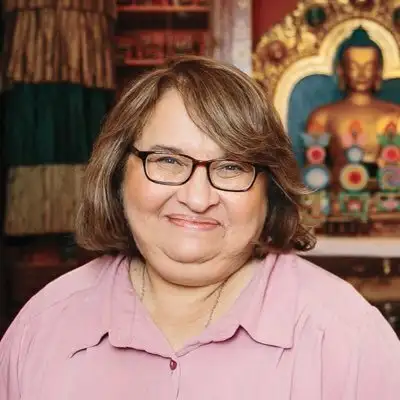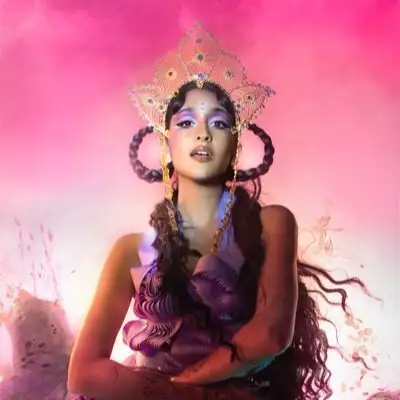Entering the Mandala - Episode 1 Transcript
Ruth Ozeki:
When I hear the word mandala…
/
/
Madame Gandhi:
I see precision. I see delicacy. I see history.
/
/
Ruth Ozeki:
The first thing that comes up is a visual image of the Tibetan tangkas,
Madame Gandhi
I see peace. I see art. I see a reflection of sort of like the
perfection of nature…
/
/
Ruth Ozeki:
These beautiful, richly painted maps of the mind, maps of the cosmos,
maps of the spiritual journey.
/
/
Tracy Dennis-Tiwary:
If you look at the veins of a leaf super close, or the DNA of a
snowflake super close, this kind of thing of where all the sacred
geometry exists around us.
/
/
Ruth Ozeki:
The mandala is so intricate, and it contains so much. It contains an
entire cosmos, an entire universe, an entire mind. That’s what makes it,
I think, such a compelling image to look at.
/
/
Raveena Aurora:
Welcome to Season 2 of AWAKEN, a podcast from the Rubin Museum of Art
that uses art to explore the dynamic path to enlightenment and what it
means to “wake up.” I’m singer and songwriter Raveena Aurora and I have
been learning about the transformative power of art throughout my life.
Since time immemorial, art has been used as a portal to better
understand ourselves and the world around us. At the Rubin, a museum
dedicated to art from the Himalayas, we believe art can inspire us on a
path to awakening. And in this series, we’re using a specific artwork,
the mandala, to explore this journey and the emotions that accompany us
on the way. With the help of many artists, the Rubin Museum created an
interactive space for visitors to explore these emotions. It’s called
the Mandala Lab.
But what is a mandala? A mandala is a guide. People from many cultures
and religious traditions around the world use mandalas as maps to
navigate their inner lives, including their emotions. Throughout this
series, with the guidance of scientists, Buddhist teachers, writers,
artists, and activists, we wrestle with five challenging emotions
—anger, pride, attachment, envy, and ignorance—to help us take a new
perspective on how emotions can influence our day-to-day experience…and
what they might be able to teach us if we get curious.
In this episode: Entering the mandala.
/
/
Dzogchen Ponlop Rinpoche:
Mandala is a Sanskrit word.
/
/
Raveena Aurora:
Dzogchen Ponlop Rinpoche is a leading Buddhist teacher and one of the
foremost scholars and meditation masters in the Nyingma and Kagyu
schools of Tibetan Buddhism.
/
/
Dzogchen Ponlop Rinpoche:
Manda actually comes from another Sanskrit root, which means the center.
That center actually is referring to like the core or the essence. And
so the core or the essence here refers to the essence that is of wisdom.
Wisdom that is at the core of our consciousness. That core, the essence
is the wisdom, and that wisdom is the wisdom of awakening. And then the
second syllable—la—means extracting or revealing or taking it out. So
together it is revealing or extracting the essence.
/
/
Raveena Aurora:
In this inaugural episode, we introduce the mandala, better understand
what it represents and how it may be used as a guide for exploring
ourselves, each other and the world.
Like many Tibetan Buddhist art works, the mandala is a visual catalyst
that can lead to awakening. Writer, photographer, translator, and
Buddhist monk, Matthieu Ricard.
/
/
Matthieu Ricard:
Mandala is really something that is used precisely to develop pure
vision, to see all sentient beings as enlightened deities, the whole
world as what you call a pure land, which is not a distant paradise to
which you could go with a rocket or something.
/
/
Raveena Aurora:
Another way of picturing a mandala is to imagine you are taking a bird’s
eye view of a celestial palace, a kind of circular floor plan, with the
most important room in the very center. Around the center circle there
are four quadrants, each with a gate that faces a cardinal direction
—north, south, east, and west. In a specific meditation, a Tibetan
Buddhist might imagine themselves navigating through layers of rooms,
moving from the outside in, towards the center, towards awakening.
/
/
Dzogchen Ponlop Rinpoche:
And so it is the circle of all aspects of our consciousness or emotions.
Another meaning is actually the center or the core refers to the wisdom
or the self-awareness. So there are like the four quadrants here that
you can see, and then the center together makes it five, there are five
primary basis what we call kleshas, or emotions, that are connected to that.
/
/
Raveena Aurora:
But what do these emotions feel like? Listen to the tones, not just the
words, and these might offer a sense.
Anger
/
/
Nora:
That’s it! You’re not getting your ball for a week!
/
/
Raveena Aurora:
Pride
/
/
Ruth Ozeki:
You do need to respect me. I made these choices for you, I made these
choices for our family.
/
/
Raveena Aurora:
Attachment
/
/
Ruth Ozeki:
What was really so painful was watching his passionate attachment to his
life just at the point where he was leaving it.
/
/
Raveena Aurora:
Envy
/
/
Sharon Salzberg:
Eww, I would be happier if you had a little bit less going for you.
/
/
Raveena Aurora:
And ignorance
/
/
Ruth Ozeki:
Oh, I know who these people are, and I don’t like them.
/
/
Raveena Aurora:
Now when we become more curious about these emotions, we can see their
true nature, see them for the wisdom they might bring us.
/
/
Matthieu Ricard:
So their true nature are the five wisdoms. It’s just a way to help us
rediscover that, is the true nature of things.
/
/
Raveena Aurora:
And that’s what this series is all about. Turning emotions into wisdom.
It’s about looking at what we often find to be difficult emotions and
transforming them into their counterpoint, their wisdom.
Ruth Ozeki is a Zen priest, professor and author, most recently of, The
Book of Formand Emptiness.
/
/
Ruth Ozeki:
A mandala–well, it’s a map of a journey, and a journey is something that
takes place over time. It takes place over time, and it moves through
space. You start a journey in one place and at one moment in time, and
you travel through space, over time, to arrive at another place in time.
And what a mandala does is, it sort of compresses space and time into a
single image and a single moment.
/
/
Dzogchen Ponlop Rinpoche:
That’s right. And mandala is also representation of our own true
existence, or representation of who we truly are, as an awakened,
completely free mind. And so mandala represents both the result as well
as the path that leads us to that result. At the same time, mandala is
also a representation that shows us who we have always been, from the
fundamental point of view. So therefore you can see, mandala is the
ground, and mandala is the path, and mandala is also the fruition.
/
/
Ruth Ozeki:
And that’s pretty cool, when you think about it. The idea that space and
time can be compressed into a single image that can be looked at and
apprehended in a moment. But then, of course, it’s not just that. Even
though you can glance up, and look at a mandala, and see it in a flash,
it really only starts to reveal itself over time again. So in order to
really see a mandala, you need to spend time with it and let the mandala
unfold and open. And that’s always interesting to me, too, because as a
maker—I write novels, and novels are a time-based medium.
/
/
Matthieu Ricard:
You don’t become a good car repairman without having a lot of
experience. So you know, hard work is necessary, and it’s good, because
you become enthusiastic, because you see what’s at the end of your
efforts. You see the fruit in perspective. But the quick fix; no, I’m
sorry, but I’m afraid it doesn’t work.
/
/
Ruth Ozeki:
A mandala makes a long time to make. The time that the maker spends,
that the painter spends painting, all of that time is compressed into
that single image. And then, it’s received by the person who’s observing
it, who’s meditating with it, who’s spending time with that image. And
then, the image sort of unfolds through time, over time, to the observer
as well.
/
/
Raveena Aurora:
The purpose of looking at the five emotions illustrated in the mandala,
is to really see the ways we can learn from our most difficult emotions
and the role our sense of self plays.
/
/
Dzogchen Ponlop Rinpoche:
The sense of ego, sense of ego clinging or self-centricity, according to
Buddhist teaching, is the root of all of the emotions, root of all of
the confusions, root of all of the sufferings. And so therefore
ego-centered mind always intercepts our experience. Whether it is
positive or negative experience, our ego always intercepts, and ego
always kind of hijacks our experience, our raw experience, you know?
[laughs]
We may be having a wonderful experience, awakening kind of experience,
or we may be having a really terrible experience, of anger for example.
Or wanting to harm oneself or others. But that experience usually is
hijacked by ego. So when the experience is hijacked by ego, then that
means that we have no chance, or no time to work with that experience,
but we’re working with something else. So original experience of your
anger with someone may be pretty simple, actually, but then when it’s
hijacked by ego, it becomes a totally different ballgame. Now, you’re
dealing with hijacker plus the issue with your anger, and so now you
have to rescue yourself from this hijacker.
And so it gets more and more complicated, because this hijacker has its
own agendas, its own troops, its own power, and its own game that it
brings in here. So then you can see how a very simple and beautiful
experience can get so convoluted and so far away from its original
experience.
/
/
Raveena Aurora:
When that sense of self is removed, we can see the experience outside of
the categories of good or bad. We can see it just for what it is.
Matthieu Ricard.
/
/
Matthieu Ricard:
So what is pure perception? Normally when we see something, perceive
something, think of something, whether it’s people, things, we
discriminate between pleasant, unpleasant, beautiful, ugly, harmonious,
discordant, friend, enemy. So we have a very biased perception of
reality. We superimpose things to reality.
We distort reality, and that distortion is the root of ignorance that
eventually leads to suffering. So, one of the goal is to bridge the gap
between appearances and reality.
/
/
Raveena Aurora:
Seeing things as they are is difficult work. We all experience a wide
range of emotions and it can be hard to know what to do with them when
they come up. Neuroscientist Tracy Dennis-Tiwary-Tiwary can offer some
insight into how to shift the emotion into something that can be more
helpful to us. In the mandala, this would be where we begin to learn
wisdom from our emotions. It isn’t age that gives us wisdom, it’s awareness.
/
/
Tracy Dennis-Tiwary:
So, you’re sitting with an emotion. The very first step is you’re
calling it by its name. So you just have to make the conscious effort
of, okay, I’m going to be with this ugly feeling right now that ...and I
may not even know what it is yet. So, that’s the first thing, that
tuning in.
Then, when you’re tuning in, I think of it like a radio. When you’re
tuning into an emotion, it’s like you have a scratchy signal on your
radio. You’re trying to find a channel, but it’s like you’re going
[makes static sounds] and you haven’t found the signal yet. So, you just
keep on turning the knob. So, that’s the investigatory piece, right? So,
you’ve been with it. You’ve tuned into it. You’ve investigated it, and
then, it’s only then when you have these kinds of practices that you can
start to figure out, okay, is this useful information that the emotion
is giving me?
So, that’s the time where we shift out of all this investigation into
what I would argue is really immersing ourself in the present. Those of
us who have spiritual practices, mindfulness practices, maybe who really
love exercise, who love music, who do these things in our life that help
us really anchor ourselves in the present moment, maybe we love to take
all walks in the forest where we just admire the beauty of the world
around us, whatever it is. There’s so many ways to immerse ourself in
the present.
Then, I’d like to think of a third and final step with using emotions,
which is especially for me because I think a lot about anxiety and how
it can help us with mental health, when we take our difficult emotions.
Maybe it is anger. Whatever it is, and we hitch it to what gives us a
sense of purpose and meaning in life, then that’s when we can start to
use emotions and really leverage them for good in our life.
So, for example,maybe I’m really anxious about climate change and where
we’re going in this world. Well, I could just sit around and be anxious
about that, or I can decide, okay, well, I’m going to be anxious about
it. I’m going to try to cope with it, but the best thing I can do is to
become an advocate and to become an activist in this area that is…I
really care about it because it’s causing me so much anxiety. I care. I
have the energy to do something because anxiety gives me that
persistence and focus and drive, so I’m going to shift it towards that.
/
/
Raveena Aurora:
While we’re learning wisdom from these difficult emotions of pride,
attachment, anger, envy, and ignorance, there are mandala-like guides
that can be found in our everyday lives. Other types of art can be
portals for enlightenment and awakening.
/
/
Ruth Ozeki:
I used to think that my writing practice and my spiritual practice were
two different things.
/
/
Raveena Aurora:
Again, Ruth Ozeki.
/
/
Ruth Ozeki:
And I was a little perplexed by that, and I think I felt a little guilty
about writing because it seemed like, especially novel-writing because
you’re just wallowing around in the realm of story. Aren’t we supposed
to be letting go of our stories? Why am I clinging to stories and, in
fact, creating new ones? I’m just perpetuating samsara here and reveling
in samsara. Surely, this must be a terrible problem. And recently, I
don’t feel that anymore at all. I feel more that writing is what I do,
and it’s my way of expressing my spiritual practice.
It is my expression of the spiritual practice that I do. And so, it’s no
longer a problem. I no longer feel there’s a separation there. And I
think that art has always been that. I think art has always been an
expression of our spiritual practice, our spiritual yearning, our
spiritual insight. It’s very inspiring. And certainly, a mandala is a
perfect example of that. But I think it applies to other media as well.
I think everyone has their own way of expressing their spiritual
practice, and it doesn’t have to be through writing novels, or writing
haiku, or painting mandala, or painting sumi-e brush paintings, or
making music. But there are so many ways of expressing our creativity
because I think our creativity is very much part of who we are as
spiritual beings. You can wash the dishes in a way that is beautiful.
You can take a walk with your child in a way that is creative, and
beautiful, and so that’s a creative expression of your…you can call it
your dharma position, your spiritual enlightenment in that moment.
We have a very, I think, sort of narrow conception of what art is. It’s
painting, it’s music, it’s poetry, it’s writing. But I think art can be
anything that’s beautiful.
I think that’s the other thing about mandala that I really love, is the
idea that the mandala really represents the interconnectedness of all
things, right? Because it’s held within this circle. And all of the
images sort of are operating in relation to all of the other elements
and images. And that is just a very beautiful and very powerful symbolic
language as well. So I really love that.
/
/
Sharon Salzberg:
Just the vast array of ways in which we are all connected is also
reflecting on the nature of mandala.
/
/
Raveena Aurora:
When we come to realize how everything is connected, our minds open, our
heart opens, we feel supported and we can help others in feeling the
same. Author and Buddhist teacher, Sharon Salzberg.
/
/
Sharon Salzberg:
Someone’s mandala might include their circle of people, right? Their
circle of friends. And something I’ve said repeatedly, more so with
memorial services than with almost any ceremony, but at times with
weddings or other things as well, when I have been at gatherings with
people that have centered on an occasion in someone’s life, or perhaps
their death, it’s always amazed me how big people’s circle sometimes is.
Like, “I didn’t know you knew people from bowling.” Or, “I didn’t know
you also knit, and you were part of this knitting club.” And, “I didn’t
know you had a book club.” It’s often how I sit there in these places.
Like, “Oh, your life was so much bigger. And I was just, like, a little
corner of it. And you had all these other arenas in which you met
people, and you cared about them, and they cared about you. Look at
that. That’s such a surprise to me.” And it’s, like, the sum total of
all those many people, and influences and relationships, that would be
somebody’s mandala. That would be somebody’s kind of representation of
their life. If you were going to put everyone’s little photo, like a
Zoom screen, on a painting or something like that.
/
/
Matthieu Ricard:
I think it can lead us to a sense of, how do you say, deeper
appreciation of interdependence, or deeper kind of look, gaining a tool
to look deeper into the interconnected nature of the world, through
which of course you can’t help but to have genuine sense of love and
compassion towards each other.
/
/
Ruth Ozeki:
I think the mandala really, again, is a kind of distillation of that
notion of interbeing, interconnectivity. I think it’s also a
representation, in a way, of community, too. it’s the community that is
within that circle. And so, there’s this sense of a kind of
representation, of connection, of kinship, of sangha, of the cosmos, on
whatever scale that might be. There’s a completeness to it. There’s a
kind of contained unity there. And in a way, it’s, of course, idealized,
too. In that sense, it’s quite inspirational. It inspires us to look at
a mandala.
/
/
Sharon Salzberg:
Another function of the mandala, whether you use it literally as a
mandala or not is remembering that we’re not alone. Because we can feel
so alone as we face adversity of some kind. But in truth, we’re not
alone. We’re never alone. And so, however you genuinely remind yourself
of that is a tool worth having.
/
/
Raveena Aurora:
We all need tools to help us navigate the complex and dynamic world of
our emotions. But maybe the most important tool of all is curiosity,
something we all have. Over the next episodes, as we listen to
reflections on anger, pride, envy, attachment and ignorance, as we tune
in to these mind states, we can bring with us our innate curiosity and
wake up to what’s possible. As Sharon says…
/
/
Sharon Salzberg:
Everybody wants to be happy.
/
/
Raveena Aurora:
And when you explore with courage…
/
/
Nora:
You’ll feel really proud because you did it by yourself.
/
/
Raveena Aurora:
And you come to find that the feelings you might be scared of have so
much to teach you…
/
/
Ruth Ozeki:
You’re holding the feeling, and turning it, and examining it, and
transforming it
/
/
Raveena Aurora:
And rather than be critical of our emotions, like anger, we can…
/
/
Mark Epstein:
Learn to hold anger like a baby. You hold it lightly. You hold it lightly.
/
/
Raveena Aurora:
Ultimately…
/
/
Ruth Ozeki:
I think these conversations about difficult emotions are the single most
important kind of conversation we can have right now to improve our lives.
/
/
Raveena Aurora:
Thank you for listening to Season 2 of AWAKEN.
------------------------------------------------------------------------
/
/
You just heard Buddhist teacher and scholar Dzogchen Ponlop Rinpoche,
psychologist and neuroscientist Tracy Dennis-Tiwary, Buddhist teacher
and author Sharon Salzberg, author, photographer, and Buddhist monk
Mathieu Ricard, Zen priest and author Ruth Ozeki, ten-year-old Nora
Wood, and activist and author adrienne maree brown.
AWAKEN is produced by the Rubin Museum of Art with Dawn Eshelman, Tenzin
Gelek, Jamie Lawyer, and Christina Watson. The series is produced in
collaboration with SOUND MADE PUBLIC including Tania Ketenjian, Emma
Vecchione, Philip Wood and Jeremiah Moore.
Music produced by Alexis Cuadrado and Hannis Brown. With some additional
tracks from Blue Dot Sessions.
AWAKEN Season 2 is part of the Rubin Museum’s Mandala Lab, a multiyear
initiative generously supported by 28 donors and sponsors. Lead support
is provided by the Milton and Sally Avery Arts Foundation, Barbara
Bowman, The Pierre and Tana Matisse Foundation, Rasika and Girish Reddy,
Shelley and Donald Rubin, and the Tiger Baron Foundation.
/Public funding is provided by the New York City Department of Cultural
Affairs in partnership with the City Council, and the New York State
Council on the Arts with the support of the Office of the Governor and
the New York State Legislature./
You can continue the conversation by following us on Instagram at
@rubinmuseum. And if you’re
enjoying this podcast, leave us a review wherever you listen to
podcasts, and tell your friends about the conversation you just heard.
This is episode 1 of a 7-part series inspired by the Mandala Lab at the
Rubin Museum—an immersive space for social, emotional, and ethical
learning. Come explore the Lab in New York City, or in one of the
installations that is traveling the world. To see the Vairochana Mandala
which inspired the Mandala Lab and this season of AWAKEN, visit
rubinmuseum.org/awaken. We look forward
to seeing you soon. Thanks for listening.





